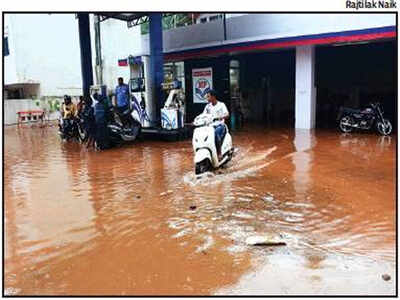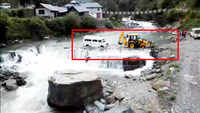
PANAJI: The issue of urban flooding, if not addressed immediately, will impact the city’s heritage buildings, experts said on Friday. They pointed out that with rainwater seepage, dampness on the plaster, and mud walls at risk, the problem could become severe to an ertent that the heritage buildings in Mala-Fontainhas could be on the verge of crumbling.
“The heritage houses in Mala, Panaji, were built with material brought from the demolished churches and houses at Old Goa. Most of the buildings are made of mud and they absorb a lot of water. This makes the walls weak. If one or two storeyed structures are built, they will possibly collapse,” heritage activist Sanjeev Sardesai said.
Conservation architect Ketak Nachinolkar stated that “since most of these heritage buildings are built using either mud or limestones, there is always some wear and tear that is bound to happen due to ageing”. “But once you have a situation like flooding, it can endanger a structure more,” he said.
There are various unimaginable things that can happen as a result of floods, Nachinolkar said, including the structure’s foundation getting destabilised, washing off the mud, dampening of walls, etc. “The district sessions court building, near tourist hostel is one such casualty.”
“The first window of this building has a lot of dampness due to ingress of water. The stone has started decaying, basically due to rain seepage. A similar situation can take place due to floods if the water doesn’t dry out,” Nachinolkar said.
The Adil Shah Place, at D B road, housing centuries-old artefacts of the Goa state museum is also at risk since the dampness can pose a threat to the health of the priceless articles, the heritage experts said.
“The building has been standing for centuries but due to rain and salinity we are worried about the paintings and wooden objects. During monsoon, there is seepage in the walls. The flood water reaches up to the verandah of the Adil Shah Palace. However, so far, the water has not entered the building,” museum director Radha Bhave said.
Infrastructure wise, the Portuguese created the city of Panaji in a grid pattern with sewage system and drainage leading from the various city spots into the Mandovi. But over a period of time, the city’s topography kept on changing, while its challenges also increased.
“The Portuguese planned the infrastructure, not the geological status. They did not raise the level of Panaji to address the flooding problem. It was a marshy land which extended from the base of the hill to the Mahalakshmi temple. They only reclaimed the land by filling up the water bodies like ponds, pools and puddles with mud from the Cortim hillock,” Sardesai said.
While the people from the bygone era may have failed to foresee this, authorities today have not been able to do justice to the infrastructure either, he said.
“The sewerage department and the municipal corporation does not clear all the drains before the monsoon. The architects and engineers of the new infrastructure are no better. They are breaking the new Miramar-Dona Paula ri=oad to let the water out. Are they kindergarten students that they did not know that the water is going to retain there? They have to give an explanation as to why the infrastructure created in modern times is again broken down, thus wasting public funds,” Sardesai said.
“The heritage houses in Mala, Panaji, were built with material brought from the demolished churches and houses at Old Goa. Most of the buildings are made of mud and they absorb a lot of water. This makes the walls weak. If one or two storeyed structures are built, they will possibly collapse,” heritage activist Sanjeev Sardesai said.
Conservation architect Ketak Nachinolkar stated that “since most of these heritage buildings are built using either mud or limestones, there is always some wear and tear that is bound to happen due to ageing”. “But once you have a situation like flooding, it can endanger a structure more,” he said.
There are various unimaginable things that can happen as a result of floods, Nachinolkar said, including the structure’s foundation getting destabilised, washing off the mud, dampening of walls, etc. “The district sessions court building, near tourist hostel is one such casualty.”
“The first window of this building has a lot of dampness due to ingress of water. The stone has started decaying, basically due to rain seepage. A similar situation can take place due to floods if the water doesn’t dry out,” Nachinolkar said.
The Adil Shah Place, at D B road, housing centuries-old artefacts of the Goa state museum is also at risk since the dampness can pose a threat to the health of the priceless articles, the heritage experts said.
“The building has been standing for centuries but due to rain and salinity we are worried about the paintings and wooden objects. During monsoon, there is seepage in the walls. The flood water reaches up to the verandah of the Adil Shah Palace. However, so far, the water has not entered the building,” museum director Radha Bhave said.
Infrastructure wise, the Portuguese created the city of Panaji in a grid pattern with sewage system and drainage leading from the various city spots into the Mandovi. But over a period of time, the city’s topography kept on changing, while its challenges also increased.
“The Portuguese planned the infrastructure, not the geological status. They did not raise the level of Panaji to address the flooding problem. It was a marshy land which extended from the base of the hill to the Mahalakshmi temple. They only reclaimed the land by filling up the water bodies like ponds, pools and puddles with mud from the Cortim hillock,” Sardesai said.
While the people from the bygone era may have failed to foresee this, authorities today have not been able to do justice to the infrastructure either, he said.
“The sewerage department and the municipal corporation does not clear all the drains before the monsoon. The architects and engineers of the new infrastructure are no better. They are breaking the new Miramar-Dona Paula ri=oad to let the water out. Are they kindergarten students that they did not know that the water is going to retain there? They have to give an explanation as to why the infrastructure created in modern times is again broken down, thus wasting public funds,” Sardesai said.
World Cup 2019
Trending Topics
LATEST VIDEOS
More from TOI
Navbharat Times
Featured Today in Travel
Quick Links
Lok Sabha Election Schedule 2019Lok Sabha Election NewsDelhi Capitals teamMI team 2019Rajasthan Royals 2019RCB team 2019Maharashtra Lok Sabha ConstituenciesBJP Candidate ListBJP List 2019 TamilnaduShiv Sena List 2019AP BJP List 2019Mamata BanerjeeBJP List 2019 MaharashtraPriyanka GandhiBJP List 2019 KarnatakaAMMK Candidate List 2019BJP List 2019 WBLok Sabha Elections in Tamil NaduBSP List 2019 UPNews in TamilLok Sabha Poll 2019Satta Matka 2018PM ModiMahagathbandhanNagpur BJP Candidate ListChandrababu NaiduTamil Nadu ElectionsUrmila MatondkarNews in TeluguMadras High CourtTejashwi YadavArvind KejriwalTejasvi SuryaPawan KalyanArvind KejriwalYogi AdityanathJaya PradaSatta King 2019Srinagar encounter
Get the app







